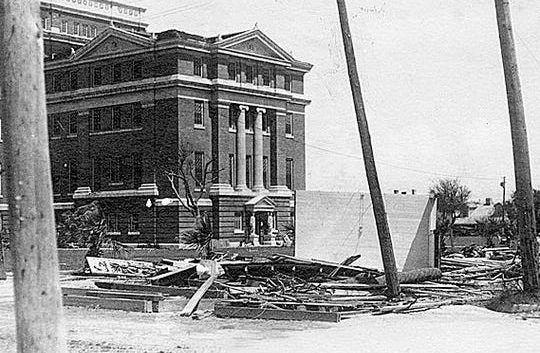- 'A little emotional': Hurricanes equipment manager got seconds in goal, memory to last a lifetime
- WMO retires three hurricane names after devastating 2024 season
- Beryl removed from future hurricane naming lists
- Hurricane names Helene, Milton and Beryl are now retired
- Hurricane Helene's name retired after deadly 2024 impact on US
THROWBACK: Survivor of Corpus Christi's 1919 hurricane created Saffir-Simpson scale

A Category 3 hurricane made landfall near Corpus Christi on Sept. 14, 1919. The city’s downtown and North Beach were decimated. Allison Ehrlich, Corpus Christi Caller-Times
Clyde Simpson pushed through waist-high water in downtown Corpus Christi Sept. 14, 1919, carrying his 6-year-old son, Robert, in his arms.
A 16-foot storm surge was being pushed ahead of a Category 3 hurricane bearing down on the city.
Except no one knew what a Category 3 hurricane was. Young Robert Simpson hadn’t invented the Saffir-Simpson scale yet.
Like other families they were escaping their flooded homes, in this case the Simpson home at 1219 Chaparral St., to seek refuge in the new Nueces County Courthouse. “He’s been chasing hurricanes ever since,” his father told the Caller-Times in 1961.
More: THROWBACK: Corpus Christi’s North Beach has experienced ups, downs and name changes galore
Robert H. Simpson graduated from Corpus Christi High School and earned his bachelor’s degree from Southwestern University in 1933. He returned to the city to teach science and music classes at his former high school before moving to Brownsville and working for the United States Weather Bureau in 1940. He earned his masters degree from Emory University, then his doctorate in geophysical sciences from the University of Chicago in 1962.
Beginning in 1955, Simpson began heading the National Hurricane Research Project and was named its director when headquarters moved to West Palm Beach, Florida the following year. He had taken part in a series of hurricane research flights in 1947 and wanted to further that research. He told the Associated Press the immediate goal of the project was to develop foolproof 24-hour hurricane forecasts.
“A lot of tragedies will be averted,” Simpson told the Caller-Times in 1956, “if we can predict the target of a storm.”
Simpson was head of the National Hurricane Center from 1968 to 1974, and it was during his time as director that he teamed up with engineer and expert on hurricane area building standards Herbert Saffir. They developed the Saffir-Simpson hurricane wind scale in 1971. Meteorologists still use it today. He died in 2014.
More: #TBT: Corpus Christi’s iconic seawall was completed in 1941 to protect downtown
As the anniversary of the 1919 hurricane approaches, consider that from the devastation of that storm, meteorology gained a tireless researcher and champion of the science. And researchers can now, thankfully, more accurately predict the hurricane paths.
Allison Ehrlich writes about things to do in South Texas and has a weekly Throwback Thursday column on local history. Help support local journalism with a subscription to the Caller-Times.
Read or Share this story: https://www.caller.com/story/news/special-reports/building-our-future/throwback/2019/09/11/saffir-simpson-inventor-survived-corpus-christis-1919-hurricane/2284656001/